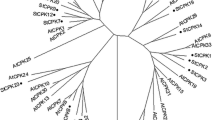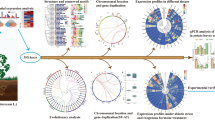Abstract
Objectives
Calcium-dependent protein kinases (CDPKs) function directly in plant development and stress responses. We used whole genome sequences and mRNA expression data to analyze the phylogenetic relationships, gene structure, collinearity, and differential expression of CDPKs in two differentially drought-tolerant potato varieties.
Results
In total, we identified 25 CDPK proteins belonging to four subfamilies. There was a significant collinear relationship among 13 CDPK genes belonging to four segmentally duplicated pairs. Subcellular prediction implied that all StCDPKs were localized at the plasma membrane. Analysis of promoter regions revealed that StCDPKs were photosensitive and responsive to biotic stress, abiotic stress, and hormone stimuli. RNA-seq analysis showed differential expression of StCDPKs among various potato tissues, and qPCR analysis revealed that 20 StCDPKs exhibited differential expression patterns under drought stress between drought-tolerant (QS9) and drought sensitive (Atl) potato varieties. Among these, the most strongly drought-induced genes were respectively StCDPK3 and StCDPK23, highlighting these as attractive candidate genes for further functional analyses of drought-stress responses in potato.
Conclusions
Our results demonstrating the tissue specific and drought stress-responsive StCDPK genes of potato both provide a reference for further research about the functions of CDPK family proteins and should support ongoing efforts for the further genetic improvement of potato.






Similar content being viewed by others
References
Consortium TPGS, Xu X, Pan S et al (2011) Genome sequence and analysis of the tuber crop potato. Nature 475:189–195
Geiger D, Scherzer S, Mumm P et al (2010) Guard cell anion channel SLAC1 is regulated by CDPK protein kinases with distinct Ca2+ affinities. PNAS 107:8023–8028
Hirsch D, Hamilton P, Childs L et al (2014) Spud DB: a resource for mining sequences, genotypes, and phenotypes to accelerate potato breeding. Plant Genome 7:1–12
Hu Z, Lv X, Xia X et al (2016) Genome-wide identification and expression analysis of calcium-dependent protein kinase in tomato. Front Plant Sci 7:469–479
Li D, Shi P, He L et al (2017) Bioinformatics analysis of calcium dependent protein kinases gene family in wild peanut. Chin J Trop Crops 38:94–103
Li M, Hu W, Ren L et al (2020) Identification, expression, and interaction network analyses of the CDPK gene family reveal their involvement in the development, ripening, and abiotic stress response in Banana. Biochem Genet 58:40–62
Liu W, Li W, He Q et al (2014) Genome-wide survey and expression analysis of calcium-dependent protein kinase in Gossypium raimondii. PLoS One 9:e98189–e98199
Liu H, Che Z, Zeng X et al (2016) Genome-wide analysis of calcium-dependent protein kinases and their expression patterns in response to herbivore and wounding stresses in soybean. Funct Integr Genom 16:481–493
Ma P, Liu J, Yang X, Ma R (2013) Genome-wide identification of the maize calcium-dependent protein kinase gene family. Appl Biochem Biotechnol 169:2111–2125
Mittal S, Mallikarjuna MG, Rao AR et al (2017) Comparative analysis of CDPK Family in maize, Arabidopsis, rice, and sorghum revealed potential targets for drought tolerance improvement. Front Chem 5:115–131
Muñiz García MN, Giammaria V, Grandellis C et al (2012) Characterization of StABF1, a stress-responsive bZIP transcription factor from Solanum tuberosum L. that is phosphorylated by StCDPK2 in vitro. Planta 235:761–778
Nie LZ, Yu XX, Ma YH et al (2018) Enhanced drought and osmotic stress tolerance in transgenic potato plants expressing AtCDPK1, a calcium-dependent protein kinase. Russ J Plant Physiol 65:865–873
Umezawa T, Sugiyama N, Takahashi F et al (2013) Genetics and phosphoproteomics reveal a protein phosphorylation network in the abscisic acid signaling pathway in Arabidopsis thaliana. Sci Signal 6:8–20
Wei C, Zhang R, Yang X et al (2019) Comparative analysis of calcium-dependent protein kinase in cucurbitaceae and expression studies in watermelon. Int J Mol Sci 20:2527–2555
Yip Delormel T, Boudsocq M (2019) Properties and functions of calcium-dependent protein kinases and their relatives in Arabidopsis thaliana. New Phytol 224:585–604
Yu TF, Zhao WY, Fu JD et al (2018) Genome-wide analysis of CDPK family in Foxtail Millet and determination of SiCDPK24 functions in drought stress. Front Plant Sci 9:651–665
Zhang K, Han YT, Zhao FL et al (2015) Genome-wide identification and expression analysis of the CDPK gene family in grape, Vitis spp. BMC Plant Biol 15:164–182
Zhang XM, Liu LX, Su ZM et al (2019) Expression analysis of calcium-dependent protein kinases (CDPKs) superfamily genes in Medicago lupulina in response to high calcium, carbonate and drought. Plant Soil 441:219–234
Zuo R, Hu R, Chai G et al (2013) Genome-wide identification, classification, and expression analysis of CDPK and its closely related gene families in poplar (Populus trichocarpa). Mol Biol Rep 40:2645–2662
Supplemental materials
Supplementary Fig. 1 Physical locations of CDPK genes in S. tuberosum. In total, 25 StCDPK genes were mapped onto the 11 chromosomes of S. tuberosum. Green bars represent chromosomes in S. tuberosum, and the scale shows chromosome length.
Supplementary Fig. 2 Ten motifs identified in the promoter regions of StCDPK genes.
Supplementary Fig. 3 Distribution of cis-elements recognized by TF families of AT-Hook, AP2/ERF, Dof, bHLH, Dehydrin, bZIP and GATA.
Supplementary Fig. 4 Distribution of cis-elements recognized by TF families of NF-YB, TCP, WRKY, HSF, ZF-HD, Trehelix and MYB.
Supplementary Table 1 All protein sequences used for phylogenetic analysis in this study.
Supplementary Table 2 The FPKM value for StCDPKs expressed in different tissues (data was extracted from Spud DB, https://solanaceae.plantbiology.msu.edu/pgsc_download.shtml).
Supplementary Table 3 Sequences of primers for qPCR used in this study.
Supplementary Table 4 List of 25 CDPK genes in S. tuberosum and their basic characterizations.
Supplementary Table 5 The cis-element categories detected using PlantCARE for the promoters of 25 CDPK genes in S. tuberosum.
Supplementary Table 6 The ten predicted motif categories detected using MEME for the promoters of 25 CDPK genes in S. tuberosum.
Supplementary Table 7 Distribution of cis-element categories detected using PlantPAN for the promoters of 25 CDPK genes in S. tuberosum.
Supplementary Table 8 The statistics of cis-element categories detected using PlantPAN.
Supplementary Table 9 References or URLs for the software used in this study.
Funding
This work was supported by the National Natural Science Foundation of China (Grant Nos. 31960442, 31660432), the Special Fund for Discipline Construction of Gansu Agricultural University (GAU-XKJS-2018-084, GAU-XKJS-2018-085), and the Research Program Sponsored by Gansu Provincial Key Laboratory of Arid land Crop Science, Gansu Agricultural University (No. GSCS-2017-8).
Author information
Authors and Affiliations
Corresponding author
Ethics declarations
Conflict of interest
All authors declare that have no conflicts of interest.
Ethical approval
This article does not contain any studies with human participants or animals performed by any of the authors.
Additional information
Publisher's Note
Springer Nature remains neutral with regard to jurisdictional claims in published maps and institutional affiliations.
Electronic supplementary material
Below is the link to the electronic supplementary material.
10529_2020_3037_MOESM1_ESM.png
Physical locations of CDPK genes in S. tuberosum. In total, 25 StCDPK genes were mapped onto the 11 chromosomes of S. tuberosum. Green bars represent chromosomes in S. tuberosum, and the scale shows chromosome length. (PNG 878 kb)
10529_2020_3037_MOESM3_ESM.png
Distribution of cis-elements recognized by TF families of AT-Hook, AP2/ERF, Dof, bHLH, Dehydrin, bZIP and GATA. (PNG 4797 kb)
10529_2020_3037_MOESM6_ESM.xlsx
The FPKM value for StCDPKs expressed in different tissues (data was extracted from Spud DB, https://solanaceae.plantbiology.msu.edu/pgsc_download.shtml). (XLSX 20 kb)
10529_2020_3037_MOESM11_ESM.xlsx
Distribution of cis-element categories detected using PlantPAN for the promoters of 25 CDPK genes in S. tuberosum. (XLSX 2732 kb)
Rights and permissions
About this article
Cite this article
Bi, Z., Wang, Y., Li, P. et al. Evolution and expression analysis of CDPK genes under drought stress in two varieties of potato. Biotechnol Lett 43, 511–521 (2021). https://doi.org/10.1007/s10529-020-03037-2
Received:
Accepted:
Published:
Issue Date:
DOI: https://doi.org/10.1007/s10529-020-03037-2




